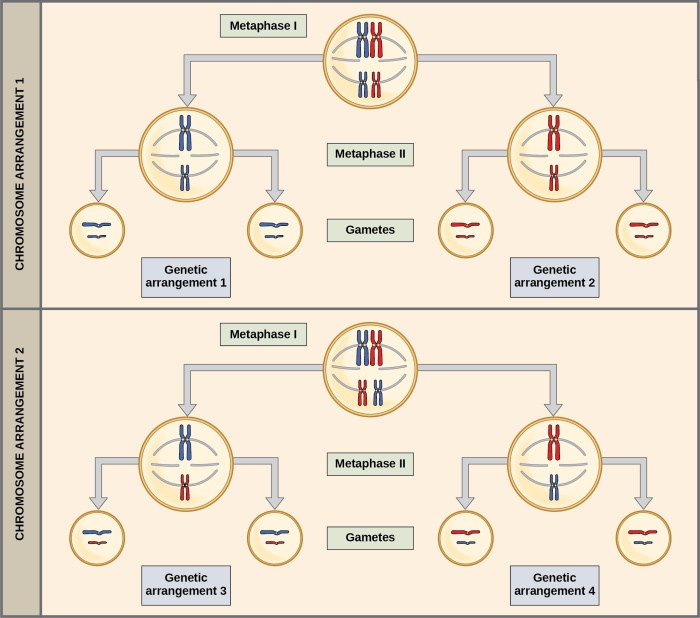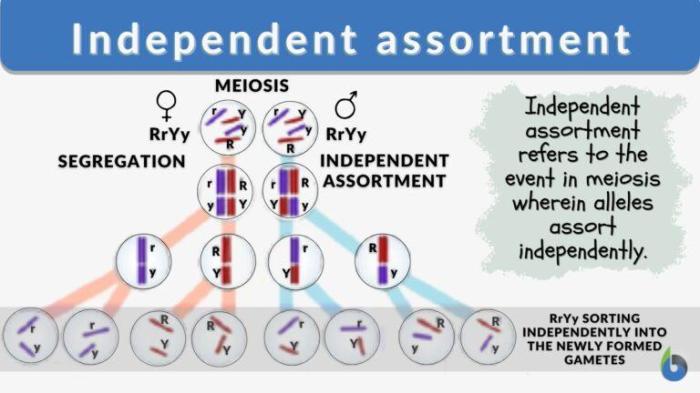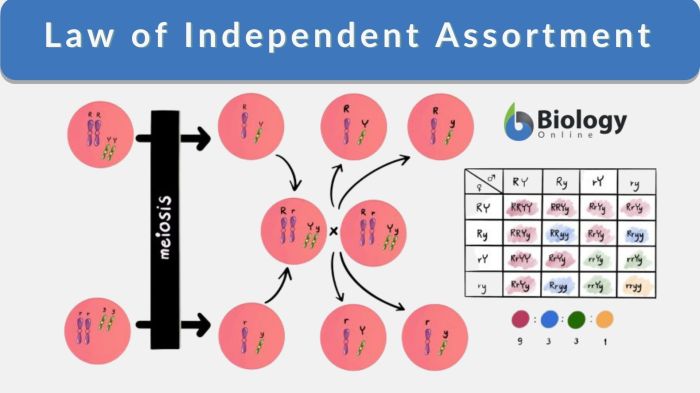What is the law of independent assortment? This fundamental principle of genetics, discovered by Gregor Mendel, explains how different traits are inherited independently of each other. It’s like shuffling a deck of cards – each card represents a gene, and the way they’re shuffled represents how these genes are passed down from parents to offspring.
The law of independent assortment is based on the idea that chromosomes, which carry our genes, separate randomly during the formation of gametes (sperm and egg cells). This random separation means that each gamete receives a mix of chromosomes from the parent, leading to diverse combinations of genes in the offspring. This process ensures genetic diversity and contributes to the unique traits we inherit from our parents.
Exceptions to Independent Assortment

The principle of independent assortment, a fundamental concept in genetics, states that alleles for different traits separate independently during gamete formation. However, there are exceptions to this rule, where genes located close together on the same chromosome tend to be inherited together.
Linked Genes
Genes located on the same chromosome are called linked genes. These genes are physically connected and are typically inherited together. The closer the genes are on the chromosome, the more likely they are to be linked. Linked genes do not assort independently during meiosis, which means they do not follow Mendel’s law of independent assortment. This results in a deviation from the expected phenotypic ratios observed in dihybrid crosses.
Crossing Over
Crossing over is a process that occurs during meiosis where homologous chromosomes exchange genetic material. This exchange can separate linked genes, leading to new combinations of alleles on chromosomes. The frequency of crossing over between two linked genes is proportional to the distance between them.
Examples of Linked Inheritance
- In fruit flies (Drosophila melanogaster): The genes for body color and wing shape are linked. The wild-type alleles for these genes are gray body and normal wings, while the mutant alleles are black body and vestigial wings. If a fly with a gray body and normal wings is crossed with a fly with a black body and vestigial wings, the offspring will not show a 9:3:3:1 phenotypic ratio as expected from independent assortment. Instead, the offspring will have a higher frequency of flies with the parental combinations (gray body, normal wings and black body, vestigial wings) than the recombinant combinations (gray body, vestigial wings and black body, normal wings). This indicates that the genes for body color and wing shape are linked and do not assort independently.
- In humans: The genes for cystic fibrosis and red hair are linked. Individuals who inherit the cystic fibrosis gene are more likely to also inherit the red hair gene.
Applications of Independent Assortment

The law of independent assortment, a fundamental principle in genetics, has far-reaching implications beyond simply explaining inheritance patterns. Its applications extend across various fields, from scientific research to practical applications in agriculture and medicine.
Genetic Research
The law of independent assortment serves as a crucial tool in genetic research, enabling scientists to understand and predict the inheritance of traits. By studying the segregation of alleles during gamete formation, researchers can map genes to specific chromosomes, identify the genetic basis of diseases, and develop strategies for genetic engineering.
Breeding Programs and Agricultural Practices
The law of independent assortment plays a vital role in breeding programs and agricultural practices. Breeders leverage this principle to create new varieties of crops and livestock with desirable traits. By crossing individuals with specific combinations of alleles, breeders can select for traits like increased yield, disease resistance, or improved nutritional content. For example, farmers use this principle to select for disease-resistant wheat varieties, ensuring greater food security and reducing crop losses.
Applications in Medicine and Disease Treatment, What is the law of independent assortment
The law of independent assortment has significant implications for understanding and treating diseases. Understanding how genes are inherited helps researchers identify genetic predispositions to certain diseases and develop personalized treatment strategies. For instance, understanding the inheritance patterns of genes associated with breast cancer can help doctors assess a patient’s risk and recommend appropriate screening and prevention measures. Furthermore, the principle of independent assortment is crucial for understanding the genetic basis of complex diseases, such as diabetes and heart disease, which are influenced by multiple genes.
Ultimate Conclusion: What Is The Law Of Independent Assortment

The law of independent assortment is a cornerstone of genetics, providing a framework for understanding how traits are inherited. This principle is not only crucial for understanding the transmission of genetic information but also has implications for breeding programs, genetic research, and even disease treatment. As we continue to explore the complexities of the human genome, the law of independent assortment remains a valuable tool for deciphering the mysteries of inheritance.
Common Queries
How does the law of independent assortment relate to Punnett squares?
Punnett squares are visual representations of the possible combinations of alleles that offspring can inherit from their parents. The law of independent assortment helps us understand how the different alleles for different traits are distributed in the Punnett square.
What are some real-world examples of independent assortment in humans?
Examples include eye color and hair color, blood type and height, or even the presence of freckles and dimples. These traits are often inherited independently, meaning that the inheritance of one trait doesn’t influence the inheritance of another.
What are some exceptions to the law of independent assortment?
Linked genes, which are located close together on the same chromosome, tend to be inherited together. This exception to the law of independent assortment occurs because linked genes are less likely to be separated during crossing over, a process that shuffles genes during gamete formation.